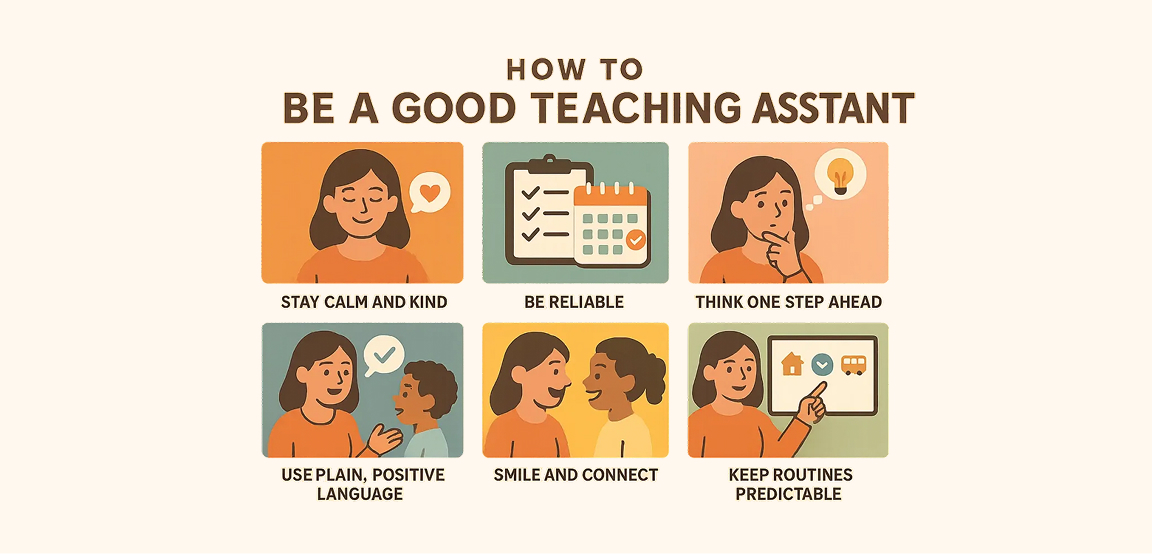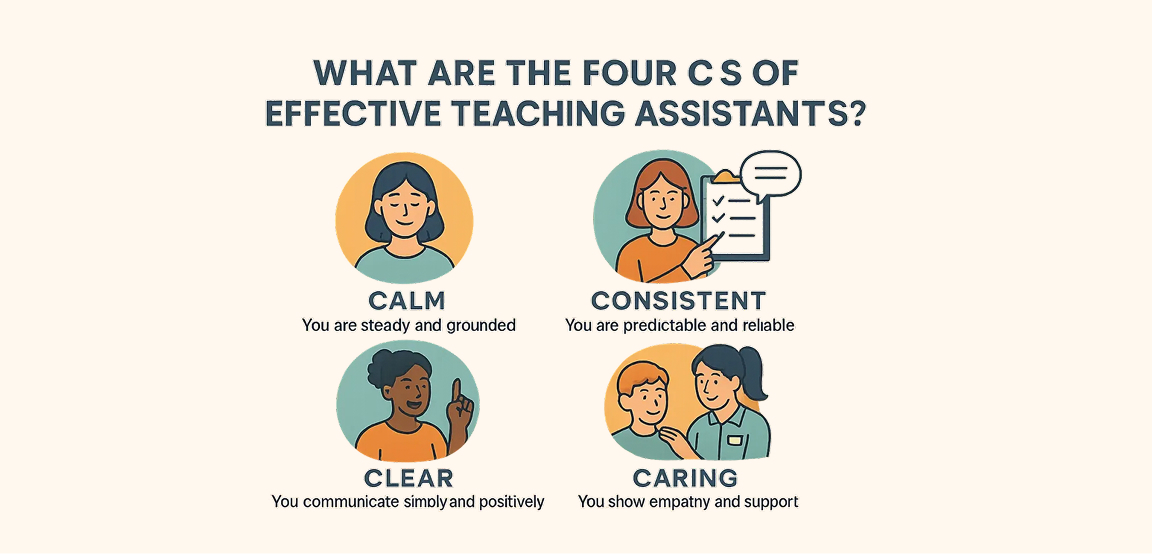If you’ve ever wondered how to be a good teaching assistant, it starts with the small things — being calm, kind, and ready to help. The best TAs show the good teaching assistant qualities that make every classroom feel safe and positive. You don’t need to know everything; you just need to care, stay patient, and keep things running smoothly so children can focus on learning.
Great TAs build trust through simple habits: clear communication, steady classroom routines, and a friendly smile. You notice who needs help, keep lessons on track, and quietly make life easier for everyone. The most supportive TAs are the ones who listen, adapt, and bring warmth into every moment — even on the busy days.
This 2025 guide shares real, practical TA best practices to help you feel confident and capable. From staying organised to supporting pupils, working with teachers, and understanding safeguarding (notice → record → report), it’s everything you need to grow in your role and make a genuine difference.
How to Be a Good Teaching Assistant

If you’ve ever wondered how to be a good teaching assistant, the secret lies in calm confidence, kindness, and consistency. A good TA doesn’t just help in class — they shape the learning environment. They notice what children need, support the teacher’s plan, and quietly make everything run more smoothly.
To do that well, focus on the habits that matter most:
- Stay calm and kind – your tone sets the mood for the whole class.
- Be reliable – arrive ready, stay organised, and follow through on tasks.
- Think one step ahead – anticipate what the teacher or pupils might need next.
- Use plain, positive language – clear instructions help everyone feel secure.
- Smile and connect – children learn best when they feel seen and valued.
- Keep routines predictable – structure builds trust and reduces anxiety.
- Notice who needs help — then act – small, timely support makes a big difference.
These are the good teaching assistant qualities that make classrooms thrive. In this 2025 guide, we’ll explore practical TA best practices, smart classroom routines, and what it means to be a genuinely supportive TA — calm, caring, and always learning.
If this feels like the kind of TA you want to be, you’re already on the right path. For a step-by-step look at how to start or grow your career, explore How to Become a Teaching Assistant in England on Unified Course.
What Are the Four C’s of Effective Teaching Assistants?

The best teaching assistants don’t rely on fancy strategies — they rely on the Four C’s: Calm, Consistent, Clear, and Caring. These four traits shape how you work, how pupils respond, and how smoothly the classroom runs. They’re simple, but powerful when you practise them every day.
- Calm means you’re the steady one in the room. When lessons get loud or plans change, you stay grounded. Pupils borrow your calm; it helps them regulate their emotions and focus again.
- Consistent TAs build trust. You keep your expectations, tone, and routines predictable, so pupils know what’s coming next. Consistency creates safety — and safe pupils learn better.
- Clear communication keeps everyone connected. You give simple, positive instructions, share what you notice, and listen carefully in return. Clarity means no confusion, no wasted time, and smoother teamwork.
- Caring ties it all together. You notice small wins, remember details, and treat every pupil with patience and respect. Real care turns support into progress — it’s what makes an effective teaching assistant more than just an extra pair of hands.
The Four C’s aren’t just skills — they’re habits. Live them daily, and you’ll see the difference: calmer days, stronger relationships, and a classroom that runs because of you.
How Can You Support the Class Teacher Effectively?
Before the Lesson
The best way to support the class teacher is to start the day prepared. Check the lesson plan and the learning goal, make sure all lesson preparation is done — books ready, tech set up, resources where they need to be. Then have a quick chat about who you’ll focus on during the lesson. That two-minute conversation can save twenty later.
During the Lesson
Think of yourself as the teacher’s second pair of eyes and ears. Walk around, notice what’s going well, and step in where children need help. Keep things calm and positive — a gentle reminder, a quick praise, a quiet check-in. This is where real teaching assistant teamwork happens: you’re tuned in, flexible, and always thinking one step ahead.
After the Lesson
Once the room settles, share quick, factual feedback. Tell the teacher what worked and what didn’t, and mention any pupils who might need extra help. Keep it short and clear — that’s effective TA communication. Then ask what to prioritise for tomorrow. Little chats like that build trust and make you both stronger as a team.
How Do You Build Positive Relationships With Pupils?
Learn Names and Greet Warmly
If you want to build relationships with pupils, start small. Learn names quickly and use them often — it shows you care. A warm greeting or a smile at the door sets a positive tone for the day. When children feel seen and valued, their pupil engagement naturally grows. They’re more likely to listen, participate, and try their best.
Listen First and Give Choices
Good relationships start with listening. Take a moment to really hear what pupils are saying — even the quiet ones. When you listen first, you build respect and trust. Use calm, kind directions and keep your language simple. Offer small choices (“Would you like to write in pen or pencil?”). These little moments of autonomy help create a positive classroom culture where pupils feel included and safe.
Use Kind Directions
Children feel respected when they have small choices: “Would you like to start with reading or drawing?” or “Do you want to sit here or near the window?” Choices give pupils a sense of control and reduce resistance. Pair that with clear, kind directions — short, calm, and friendly — and the class feels safer and more predictable.
Praise and Recognition
The most powerful thing you can give a child is honest encouragement. Notice the effort, not just the outcome — “You kept trying, and that’s progress.” Celebrate persistence, kindness, and curiosity. Genuine praise and recognition help children believe in themselves and strengthen your bond with them. Over time, those small words shape confident, motivated learners who know you’re on their side.
What Skills Help You Stand Out as a TA?
If you want to shine in your role, focus on the practical, everyday teaching assistant skills that make classrooms calm, organised, and ready for learning. The best TAs don’t try to do everything — they do the small things really well.
Key Skills to Focus On
- Communication: Break tasks into tiny, clear steps so pupils know exactly what to do. Model once, then guide and encourage. Use a calm, confident voice — it helps everyone feel safe and focused.
- Behaviour Support: Consistency is everything. Use the same signals, routines, and calm tone every time. These simple behaviour support strategies create structure and help pupils reset without embarrassment.
- SEN Support Basics: Small tweaks make a big impact. Use visuals, timers, and short “chunks” of work to keep focus high and frustration low. Great SEN teaching assistants make learning accessible for every child.
- Organisation and IT Confidence: Keep resources tidy and know your way around classroom tech. Confident classroom IT skills — like managing displays, printers, and learning apps — make lessons smoother and save valuable time.
- Record-Keeping: After each session, make quick notes on pupil progress or challenges. Short, factual observations help the teacher plan next steps and track learning over time.
A great TA blends care with competence — steady communication, smart systems, and a calm presence that helps learning happen.
How Do You Support SEN Pupils Confidently?
Supporting pupils with additional needs starts with understanding them as individuals. Read their IEP or EHCP carefully so you know the goals, adaptations, and key strategies that help each child succeed. The best way to support SEN pupils is to prepare — learn what works, what triggers stress, and how to adapt before the lesson begins. Even small adjustments can make a big difference.
Visuals are your best friend. Use now–next boards, picture cues, or short written prompts to help pupils see what’s coming next. Combine that with timers for focus, movement breaks to reset energy, and calm, plain language to avoid overload. These simple autism and ADHD classroom strategies help pupils feel safe and stay on task without constant reminders.
Communication is key — both with pupils and staff. Agree on quiet signals or gestures that help a pupil ask for help discreetly. Log what works well so others can use the same approach. And if you’re ever unsure, check in with the SENCO for guidance. Following SENCO guidance keeps support consistent and builds your confidence, too. Over time, you’ll learn that the heart of great SEN support isn’t about doing more — it’s about understanding better.
How Can You Stay Organised and Prepared Every Day?
Build Your TA Toolkit
Every organised teaching assistant needs a toolkit that’s ready to go. Keep essentials like whiteboard pens, sticky notes, timers, and spare pencils in one place so you can grab what you need fast. Add handy extras — glue sticks, rubber bands, a mini stapler — because being prepared for small things saves big time later.
Preview and Prepare
Before lessons start, spend a few quiet minutes on classroom preparation. Read the plan, print or gather resources, and lay them out where they’ll be used. Check which pupils might need support and make sure everything’s easy to access. This calm start makes you feel in control and helps lessons flow smoothly from the first minute.
Use Checklists and Routines
Simple checklists can keep your day on track. Note what needs prepping, what’s done, and what needs following up. Build small routines — a morning setup, a mid-day reset, and an end-of-day tidy. The more automatic these habits become, the less you’ll forget when things get busy. It’s one of the easiest time management TA tricks there is.
Keep a Mini Intervention Log
A quick intervention log is worth its weight in gold. Record who you helped, what the goal was, and how it went — just a few words per pupil. This shows real progress and helps teachers and SENCOs plan next steps. Over time, it also builds your confidence as you can see the difference you’ve made.
Plan for the Unexpected
Even the best plans go sideways sometimes — the printer jams, the glue sticks vanish, or the timetable changes. Stay flexible and keep a calm, practical mindset. Have a spare activity or quick brain break ready to fill gaps. Great organisation isn’t about control; it’s about being prepared enough to adapt easily.
Reset Between Lessons
When one lesson ends, take two minutes to reset the space. Put resources back, check what’s next, and take a breath. A tidy table and a clear mind make a world of difference. Small resets keep your focus sharp and your energy balanced throughout the day.
What Training Helps You Be a Better Teaching Assistant?
Keep learning — it’s what makes a good TA great.
The best classrooms run on curiosity, not just for pupils but for staff too. Ongoing teaching assistant training keeps you confident, capable, and ready for anything a school day brings.
Core Courses That Matter
- Safeguarding course: Always first. It protects pupils — and you.
- SEN awareness: Learn practical autism and ADHD classroom strategies that really work.
- Phonics training: Strengthen reading support and help every child find their voice.
- ELSA & SEMH: Build empathy and emotional insight for calmer, happier classrooms.
- Paediatric First Aid: Because being ready in a crisis is part of being reliable.
Next Steps for Your Career
When you’re ready to grow, aim for Level 3 qualifications and HLTA progression. These open doors to leading groups, planning interventions, and taking more responsibility — while still doing what you love.
Learn Online with Unified Course
If you’re serious about growing as a teaching assistant, Unified Course is where you start. It’s a trusted CPD platform built for real schools — flexible, affordable, and created by educators who understand what classrooms are really like.
You can choose from focused modules on everything that matters:
Level 2 Safeguarding Children Training Course, Phonics Teaching Course, ELSA and SEMH, and more. Each course is practical, short enough to fit into your week, and designed to give you ideas you can use straight away. Whether you’re building confidence or aiming for promotion, Unified Course helps you keep moving forward.
Learn at your own pace, earn certificates that count, and join thousands of TAs already improving their skills online.
Start learning today with Unified Course — because great teaching assistants never stop growing.
How Can You Handle Stress and Stay Positive?
Working in a school is rewarding — but it’s also busy, emotional, and sometimes overwhelming. Good teaching assistant wellbeing starts with small, daily habits that protect your energy. Take short, steady breaths between tasks, keep a drink nearby, and step outside for a quick reset when you can. These moments of pause help you stay calm and focused when the day feels full.
Stress management for TAs is about communication as much as care. Share worries early with your teacher or SENCO, and use debriefs to talk through what went well — and what didn’t. Setting clear boundaries matters too: once the day ends, let it end. Move your body, rest your voice, and switch off for a while. A clear head makes you better support tomorrow’s learners.
Don’t forget to notice your wins. That quiet breakthrough with a pupil, that tidy table, that smile you got back — celebrate them. They’re proof you’re making a difference. If something felt tough, jot down one thing to try differently next time. That’s real TA self care and workload balance — not perfection, just progress.
How Do You Know You’re Doing a Good Job as a TA?
Sometimes it’s hard to measure your own impact — but the signs are there if you know where to look. Strong TA performance indicators aren’t about praise or perfection; they’re about progress. You’ll notice the classroom feels calmer, pupils understand routines, and transitions happen more smoothly. Fewer disruptions mean your quiet consistency is working.
Real success shows up in pupil progress. The children you support start meeting objectives, showing independence, and taking pride in their work. You’ll see confidence where there used to be hesitation — and that’s a powerful measure of an effective teaching assistant. The teacher might act on your notes, trust your observations, or ask for your input more often — that’s teamwork in action.
And finally, you’ll feel it. When you pack up at the end of the day, you’ll know what went well and what to tweak tomorrow. You’ll sense that you’re part of something bigger — learning that works, children who thrive, and a classroom that runs because you’re in it. That’s real classroom impact — quiet, steady, and essential.
Final Thoughts: Becoming a Confident, Valued Teaching Assistant
You’ve equipped yourself with the tools, insight, and mindset to make a real difference. Remember: being a great TA doesn’t mean doing everything perfectly — it means showing up, adapting, and growing day by day. Every calm voice, every small encouragement, every well-prepared lesson is a thread in the fabric of learning.
If you’re ready to deepen your skills and gain credentials that matter, consider enrolling in the Teaching Assistant course at Unified Course. Their modules are practical, flexible, and created by people who know what life in classrooms really looks like. This is your chance to stand out, feel confident, and build a career full of purpose.
You’re not just supporting — you’re shaping futures. Keep learning, keep believing in your impact, and let your growth become the quiet legacy of every classroom you enter.
FAQs on How to Be a Good Teaching Assistant
1. What qualities make a good teaching assistant?
A good TA is calm, consistent, and caring. They listen, communicate clearly, and stay organised. The best teaching assistants notice what pupils need before they ask and bring steady energy that helps everyone learn.
2. How can I improve as a TA?
Ask for feedback, observe great teachers, and keep learning. Focus on small wins — clear instructions, timely praise, tidy spaces. Continuous CPD through platforms like Unified Course helps you stay confident and up to date.
3. What should a TA not do?
Never take over teaching unless directed. Avoid discussing pupils publicly or sharing confidential information. Stay professional, follow safeguarding procedures, and always check with the teacher before making big changes.
4. What makes the best TA?
The best TAs balance initiative with teamwork. They’re proactive, reliable, and genuinely enjoy seeing pupils succeed. They build trust by being calm under pressure and always putting learning first.
5. How to handle disruptive behaviour in the classroom?
Use calm, consistent strategies. Give clear, short instructions, use non-verbal cues, and narrate positive behaviour (“I can see Sam ready to start”). Follow your school’s behaviour plan and stay steady — not loud.
6. What are the four C’s of effective teaching assistants?
The Four C’s are Calm, Consistent, Clear, and Caring. These traits build trust, create routine, support communication, and show pupils they’re valued. Together, they define an effective teaching assistant.
7. What does Ofsted say about teaching assistants?
Ofsted highlights that TAs should be well-trained, well-directed, and focused on supporting learning — not just managing behaviour. Inspectors look for clear teamwork between teachers and TAs that leads to pupil progress.
8. What are the 5 E’s in teaching?
The 5 E’s are Engage, Explore, Explain, Elaborate, and Evaluate. They’re a teaching model that helps lessons flow naturally and keeps pupils active and curious about their learning.
9. What are the 4 A’s in teaching?
The 4 A’s are Awareness, Action, Assessment, and Adaptation. They remind teachers and TAs to notice pupil needs, respond thoughtfully, check understanding, and adjust support as learning develops.




